|
|
|
|
|
|
|
|
|
In January 1841, managers from the various railway companies met in Birmingham to discuss the standardisation of matters relating to safety. One of their recommendations was for every company to adopt the Liverpool & Manchester Railway's signalling colours (red for 'danger', green for 'caution', white for 'clear') as standard. The first ever railway semaphore signal, which was installed later in 1841 on the London & Croydon Railway, displayed these new standard colours as its nighttime indications (see [2.1 - 2.3]).
The 'flag signal' or 'kite' was introduced on the Great Western Railway from February 1841 to display the 'caution' indication, usually in conjunction with a disc and crossbar signal with which it was co-located and positioned at a lower height. It consisted of a pair of coloured curtains inside a triangular frame. When the red flag was unfurled [1.28], it indicated 'danger', and the green flag unfurled meant 'caution' [1.29].
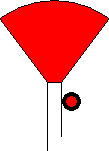 |
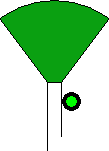 |
|
[1.28] Flag Signal showing 'Danger'.
Area: GWR Usage: Unknown Status: Historical |
[1.29] Flag Signal showing 'Caution'.
Area: GWR Usage: Unknown Status: Historical |
|---|
The flag signals were prone to being torn to ribbons every few days by the wind, leading Brunel to introduce the 'caution board' or 'fantail' as their replacement in January 1842. This comprised an arrow-shaped board painted red on one side and green on the other. When the board pointed towards the track and the red side was visible to approaching trains [1.30], the meaning was 'danger'. When the board pointed away from the track with its green side visible [1.31], it indicated 'caution'. After the 'caution' time interval had expired, the caution board was turned edge on to the track so as to be practically invisible.
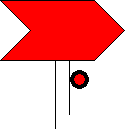 |
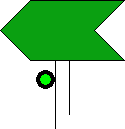 |
|
[1.30] Caution Board showing 'Danger'.
Area: GWR Usage: Unknown Status: Historical |
[1.31] Caution Board showing 'Caution'.
Area: GWR Usage: Unknown Status: Historical |
|---|
Early in 1842, the discs and crossbars on the disc and crossbar signals (see [1.24 - 1.27]) were repainted red to improve their visibility [1.32 - 1.35]. Consequently, the two daytime indications were distinguished only by their different shapes.
 |
 |
|
[1.32] Disc and Crossbar Signal showing 'Danger'.
Area: GWR Usage: Unknown Status: Historical |
[1.33] Disc and Crossbar Signal showing 'Clear'.
Area: GWR Usage: Unknown Status: Historical |
|---|---|
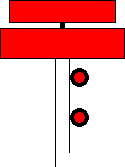 |
 |
|
[1.34] Double Disc and Crossbar Signal showing 'Danger'.
Area: GWR Usage: Unknown Status: Historical |
[1.35] Double Disc and Crossbar Signal showing 'Clear'.
Area: GWR Usage: Unknown Status: Historical |
In addition to the usual red vanes for 'danger' (see [1.5]), signals on the Edinburgh & Glasgow Railway had a single green vane for 'caution' [1.36] and a white vane for 'clear' [1.37].
 |
 |
|
[1.36] Vane Signal showing 'Caution'.
Area: Edinburgh & Glasgow Railway Usage: Unknown Status: Historical |
[1.37] Vane Signal showing 'Clear'.
Area: Edinburgh & Glasgow Railway Usage: Unknown Status: Historical |
|---|
|
A board signal could indicate 'caution' by being painted green on one side and showing a green light at night [1.38]. |
|
The Caledonian Railway used a board signal with a tab protruding from one edge. One side of the board was painted red for indicating 'danger' [1.39], and the other side was green for 'caution' [1.40]. The tab was an aid to determining the signal's indication at times when colour recognition was hampered by adverse light conditions. Drivers knew that if the tab was on the right-hand side, nearest the track, the signal was displaying 'danger'. To indicate 'clear', the board was turned edge on and a white light was shown at night (see [1.2]).
 |
 |
|
[1.39] Board Signal showing 'Danger'.
Area: Cal.R Usage: Unknown Status: Historical |
[1.40] Board Signal showing 'Caution'.
Area: Cal.R Usage: Unknown Status: Historical |
|---|
As an alternative to the tab, signals on the Central Division of the Caledonian Railway had one edge shaped like an arrow [1.41 & 1.42], similar to the GWR's 'fantail' signal (see [1.30 & 1.31]).
 |
 |
|
[1.41] Board Signal showing 'Danger'.
Area: Cal.R Usage: Unknown Status: Historical |
[1.42] Board Signal showing 'Caution'.
Area: Cal.R Usage: Unknown Status: Historical |
|---|
|
The first signals on the Glasgow & South Western Railway were of the 'double vane' type and were in use from the 1840s. As well as being able to show two red vanes for 'danger' (see [1.19]), the signals could display two green vanes for 'caution' [1.43]. In the 'clear' position, no vanes were visible, but a white light was shown during darkness (see [1.2]). |
|
|
|
|